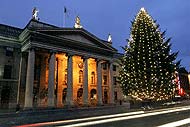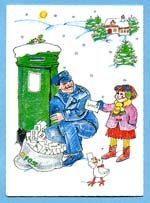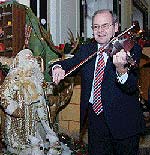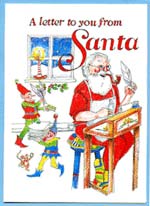



Custom Search
|
|
"People will not look forward to posterity who never look backward to their ancestors." Quotes Shops Ireland Bunús na Gaeilge Did You Know? Himself/Herself Write to Us Readers Write.. Links/Link to Us Advertise with us Awards & Testimonials |
 An Post at Christmas An Post at ChristmasEdited and adapted by Bridget Haggerty For well over a hundred years, there has been in the public mind a particularly close association between the Post Office and Christmas time. Christmas cards, letters from abroad, turkeys, geese and parcels of every description are happily linked with the image of a heavily-laden but cheerful postman. Despite great changes in technology in recent years, the link between Christmas and the Post Office survives and Santa Claus himself still depends on An Post to bring him the many thousands of letters written by children throughout the country. How did all this begin? The connection with the Post Office goes back at least to the invention of Christmas cards and to Henry Cole who is credited with introducing them. Cole had worked with the postal reformer, Rowland Hill, on the introduction of universal penny postage and the famous Penny Black stamp. In 1843 he arranged for the design and printing of one thousand hand –coloured cards which he sold at the high price of 6d - about 3 cents in today’s currency but a lot of money at the time and well beyond the reach of most ordinary people. Slowly, however, the idea of sending a special greeting card at Christmas caught the imagination and by 1881 the Post Office thought it wise to issue its first “Post early for Christmas” message in order to cope with the additional mail volumes.  Early Christmas cards generally show Santa dressed in green in anticipation of the spring-time that would put an end to winter’s grip. His red costume originated later in the United States and spread back to Europe. Scenes of festivity and traditional Biblical motifs formed the most popular themes on cards but, with the increasing importance of the Post Office at Christmas time, card manufacturers would sometimes incorporate a postal image – a snow-covered pillar box for instance or children awaiting the arrival of the postman. Early Christmas cards generally show Santa dressed in green in anticipation of the spring-time that would put an end to winter’s grip. His red costume originated later in the United States and spread back to Europe. Scenes of festivity and traditional Biblical motifs formed the most popular themes on cards but, with the increasing importance of the Post Office at Christmas time, card manufacturers would sometimes incorporate a postal image – a snow-covered pillar box for instance or children awaiting the arrival of the postman.In days when letters were still the main form of communication between people, it was expected that postal staff would provide normal services on Christmas day. Occasionally, there was generosity on the part of the Post Office as an employer: eighty-odd years ago the Postmaster General conceded that an “official Christmas breakfast” might be funded out of official funds for staff engaged on the 4am duties on Christmas day. This concession, however, was experimental and was not repeated the following year! It was normal for local delivery staff to remain on duty until the final incoming mails had been received, even if they were late, and staff might not get home to their families until the evening. Pressure from staff eventually brought change and, for the first time, there was no Christmas day delivery in 1937.  As mail volumes grew, it became necessary to take on extra staff at Christmas and, in difficult economic times, applications for those Post Office jobs far exceeded the number of positions available. Although Christmas volumes have been affected by technological innovations and changing writing habits, An Post still takes on extra staff at Christmas in order to cope with the nearly 100 million additional items that pass through the postal system over the Christmas period. As mail volumes grew, it became necessary to take on extra staff at Christmas and, in difficult economic times, applications for those Post Office jobs far exceeded the number of positions available. Although Christmas volumes have been affected by technological innovations and changing writing habits, An Post still takes on extra staff at Christmas in order to cope with the nearly 100 million additional items that pass through the postal system over the Christmas period.In recent years a visit to the GPO at lunchtime during December has become a traditon for many Dubliners. This visit is not just to buy the Christmas Stamps but to listen to the wonderful Christmas Music provided by Noel Carroll and his trusty bunch of volunteer musicians.  Santa’s Letters Santa’s LettersAn Post has been helping Santa with his Christmas post for over 20 years. An Post’s Chief Elf, Feargal reminds children to get writing that ALL IMPORTANT letter to SANTA as early as possible. Letters should be addressed to Santa Claus, North Pole. Santa loves reading the colourful and creative letters he receives from children in Ireland and Chief Elf Feargal asks children to remember to write their name and address clearly so that Santa can reply. But don’t worry if letters are sent to Santa too late for a reply, he will still be visiting on Christmas Eve. A bulletin about Letters to Santa for children in Ireland Chief Elf, Feargal says be sure to write early. In your letter clearly write your name and address. Put your letter in an envelope and address it to: Santa Claus, North Pole. Don't forget to put a 60c stamp on the envelope. Santa's helpers in An Post will make sure you receive a personal reply from the great man himself, just before Christmas. An Post Christmas fun for children Copy Source: An Post |
 Ilnacullen, Co. Cork - an Island Garden Ilnacullen, Co. Cork - an Island GardenLocated in the sheltered harbour of Glengarriff in Bantry Bay. Ilnacullin, which means island of holly, is a small island known to horticulturists and lovers of trees and shrubs all around the world as an island garden of rare beauty. |
||||||
|
|
||||||||
| All contents copyright © 2001 through 2011 inclusive - all rights reserved. March 4, 2011 |
Rollover button Images: Wedding LaRose, Kids Reading & Kitchen Apples and Tea from All Posters prints. The information provided on this site is offered as-is, without warranty. This site's owners, operators, authors and partners disclaim any and all liability from the information provided herein. Any trademarks or registered trademarks on this site are the property of their respective owners. |
This Web Site Bashed, Kicked & Glued together by Russ Haggerty. |
||||||